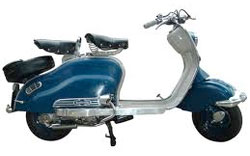Lambretta Model 150 D/LD


150 D SpecificationsYears produced: 1954 - 1956 (D)Amount produced: 54,591 Engine: 1 cylinder, air cooled 2-stroke Induction: piston ported Bore: 57 mm Stroke: 58 mm Cubic capacity: 148 cc Compression ratio: 6.5:1 BHP at rpm: 6 @ 4750 Transmission: 3 speed (hand) Lubrication: 5% Carburetor: Dellorto MA 19 B4 Ignition: contact breaker & points Ignition timing: 24-26 degrees BTDC Breaker gap: 0.3-0.4 mm Voltage: 6 volt Wheel size: 8" Tire size: 4 x 8 Max speed: 49 mph Total dry weight: 165 lbs |
150 LD SpecificationsYears produced: 1954 - 1957 (LD)Amount produced: 219,530 Engine: 1 cylinder, air cooled 2-stroke Induction: piston ported Bore: 57 mm Stroke: 58 mm Cubic capacity: 148 cc Compression ratio: 6.5:1 BHP at rpm: 6 @ 4750 Transmission: 3 speed (hand) Lubrication: 5% Carburetor: Dellorto MA 19 B4 Ignition: contact breaker & points Ignition timing: 24-26 degrees BTDC Breaker gap: 0.3-0.4 mm Voltage: 6 volt Wheel size: 8" Tire size: 4 x 8 Max speed: 49 mph Total dry weight: 194 lbs |
LAMBRETTA MODEL 150 D/LD HISTORY
Since Innocenti was always listening to the demands of the ever expanding scooter market, it chose the 1954 Motosalone Internazionale di Milano to unveil the new 150 D and LD, which derived from the ever popular 125 D and LD. The new versions of this classic model were offered in the same two categories: the economic 150 D and the luxurious covered 150 LD.
The expanding displacement of the engine and the resulting power gain was a step forward for the Lambretta, especially the covered version since the weight of the sidepanels and its lack of wind resistance slowed it down considerably. The additional power of the 150 engine, now at approximately six horsepower, was not used to raise the overall speed of the scooter, but to improve the shifting of the gears, the acceleration, and its power in climbing hills. The new and improved gear ratio allowed the scooter to make it up a 35% grade hill and pass most terrain without a problem.
The forced air cooling system of the covered LD version was also put on the economic 150 D to ensure a constant temperature for the engine even in the worst weather conditions.
The characteristic rear suspension of the torsion bar attached to the swinging motor had already been thoroughly tested on the 125, but had the welcome addition of an efficient hydraulic, telescopic shocks that made the overall handling more comfortable and safe even on the most uneven surfaces.
With the new 150 series, the Lambretta lost once and for all the Teleflex rod-shifting system and adopted the classic double bowden cables, which were universal for all major producers of motorcycles and scooters at that time. Innocenti also changed the exhaust system by adding an expansion chamber to further reduce the noise. A large air filter was put on the carburetor and another jet was added to aid starting. The gas control and electrical system was improved by control lights on the dash. Furthermore, the control for the opening of the gas tank and the starter were now positioned on the outside of the bodywork under the front seat. An option that was now standard was a convenient glovebox behind the legshield with a tachometer on the top and an optional clock.
In the slightly more than two years in which it was produced, the Lambretta 150 received numerous improvements almost monthly. The unfortunate part that tormented scooter drivers was undoubtedly the starter. Innocenti modified the whole system at least four times without ever being able to totally solve the problem.
To adapt to the new standards of the Italian highway laws, the Lambretta 150 was equipped with a six volt battery and rectifier at the end of 1955. Apart from being able to have the headlights on while the motor was turned off, the new battery improved the overall performance of the scooter. In the middle of 1956, the chromed expansion chamber on the exhaust was done away with and replaced with a more economic and robust muffler.
Also in 1956, a new version of the LD was offered with a LD. Innocenti cut corners to offer this version at a more affordable, competitive price. The protective covers for the handlebar cables were eliminated, the electrical system was simplified by eliminating the battery, the glovebox behind the legshield was not standard, and cheaper seats were used. Even the 150 D version was built in smaller numbers, probably for the Swiss market.
The top-of-the-line, luxury 150cc version with electric start was requested by a few of the larger exporters in mid-1956 for the foreign market. Between 1956 and 1957, 5,000 units of a special version of the 150 LD were built just for the English market.
At the end of 1956 production of the 150 D stopped, which was the end of an era for Innocenti. It was the last "uncovered" Lambretta that saw the light of day, a tradition that began in 1947 with the 125 A. The LD, on the other hand, would continue to be built in a new version known as the LD 57.
The parts book can be found here: D/LD 125-150 MK 2-3 derived
